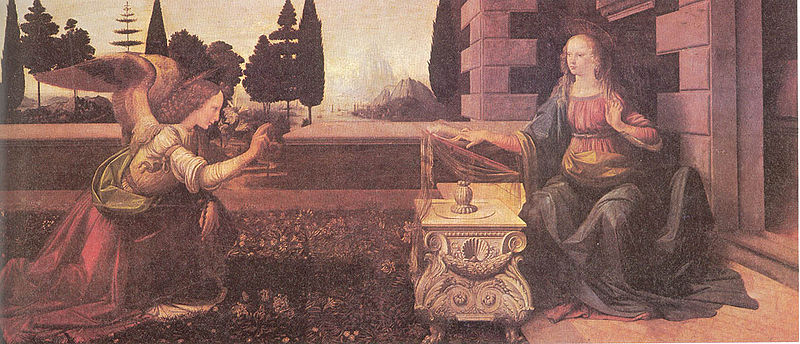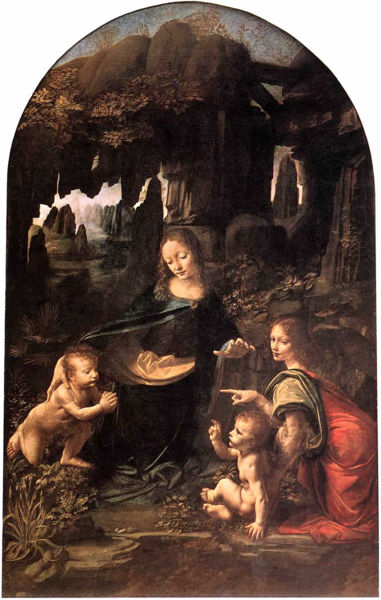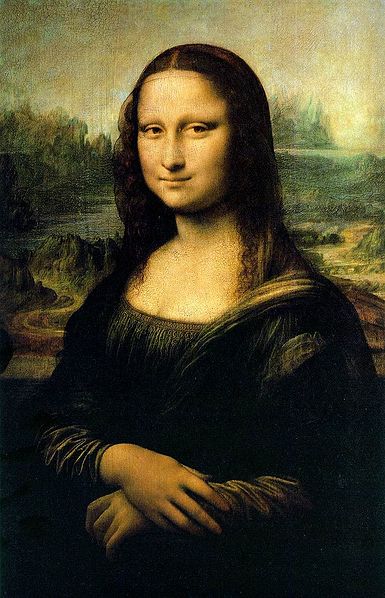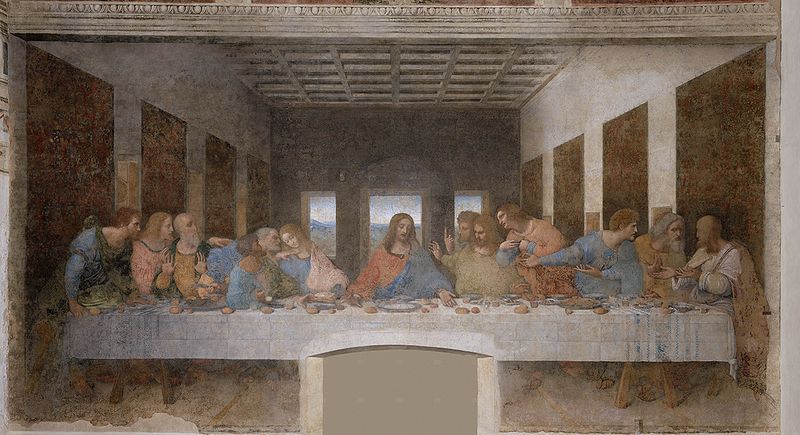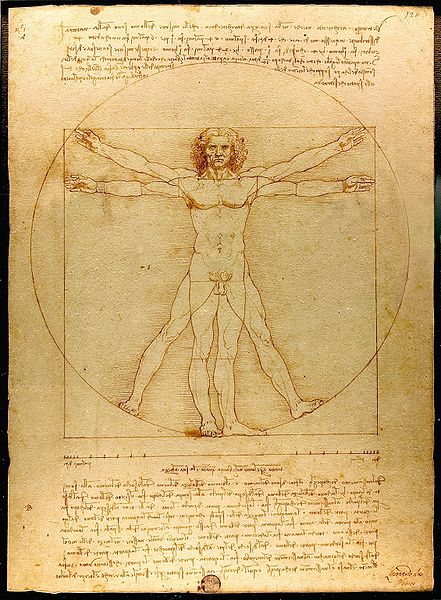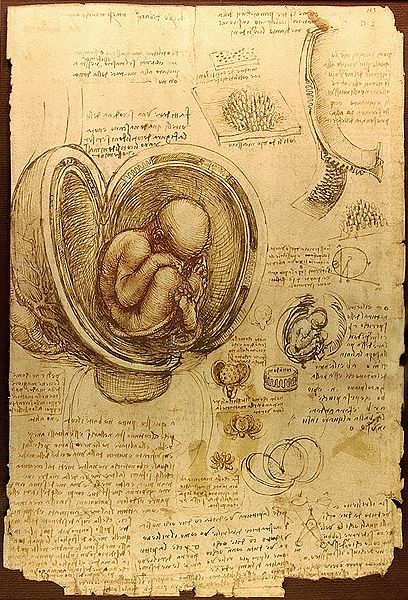<Back to Index>
- Mathematician Leonhard Paul Euler, 1707
- Painter Leonardo di ser Piero da Vinci, 1452
- Chairman of the Presidium of the Supreme Soviet Nikita Krushchev, 1894
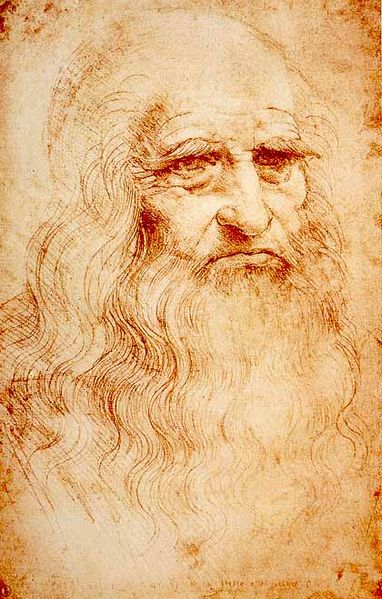
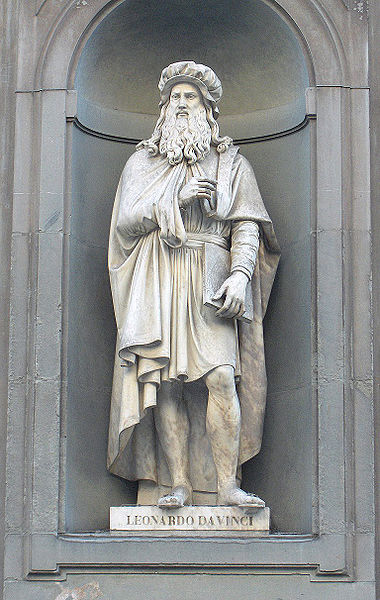
Leonardo di ser Piero da Vinci (April 15, 1452 – May 2, 1519), was an Italian polymath: painter, sculptor, architect, musician, scientist, mathematician, engineer, inventor, anatomist, geologist, botanist and writer. Leonardo has often been described as the archetype of the Renaissance man, a man whose unquenchable curiosity was equaled only by his powers of invention. He is widely considered to be one of the greatest painters of all time and perhaps the most diversely talented person ever to have lived.
Born the illegitimate son of a notary, Piero da Vinci, and a peasant woman, Caterina, at Vinci in the region of Florence, Leonardo was educated in the studio of the renowned Florentine painter, Verrocchio. Much of his earlier working life was spent in the service of Ludovico il Moro in Milan. He later worked in Rome, Bologna and Venice and spent his last years in France, at the home awarded him by Francis I.
Leonardo was and is renowned primarily as a painter. Two of his works, the Mona Lisa and The Last Supper, are the most famous, most reproduced and most parodied portrait and religious painting of all time, respectively, their fame approached only by Michelangelo's Creation of Adam. Leonardo's drawing of the Vitruvian Man is also regarded as a cultural icon, being reproduced on everything from the Euro to text books to t-shirts. Perhaps fifteen of his paintings survive, the small number due to his constant, and frequently disastrous, experimentation with new techniques, and his chronic procrastination. Nevertheless, these few works, together with his notebooks, which contain drawings, scientific diagrams, and his thoughts on the nature of painting, comprise a contribution to later generations of artists only rivalled by that of his contemporary, Michelangelo.
Leonardo is revered for his technological ingenuity. He conceptualised a helicopter, a tank, concentrated solar power, a calculator, the double hull and outlined a rudimentary theory of plate tectonics. Relatively few of his designs were constructed or were even feasible during his lifetime, but some of his smaller inventions, such as an automated bobbin winder and a machine for testing the tensile strength of wire, entered the world of manufacturing unheralded. As a scientist, he greatly advanced the state of knowledge in the fields of anatomy, civil engineering, optics, and hydrodynamics. Leonardo was born on April 15, 1452, "at the third hour of the night" in the Tuscan hill town of Vinci, in the lower valley of the Arno River in the territory of Florence. He was the illegitimate son of Messer Piero Fruosino di Antonio da Vinci, a Florentine notary, and Caterina, a peasant. Leonardo had no surname in the modern sense, "da Vinci" simply meaning "of Vinci": his full birth name was "Leonardo di ser Piero da Vinci", meaning "Leonardo, (son) of (Mes)ser Piero from Vinci". Little is known about Leonardo's early life. He spent his first five years in the hamlet of Anchiano,
then lived in the household of his father, grandparents and uncle,
Francesco, in the small town of Vinci. His father had married a
sixteen-year-old girl named Albiera, who loved Leonardo but died young. When
Leonardo was sixteen his father married again, twenty-year-old
Francesca Lanfredini. It was not until his third and fourth marriages
that Ser Piero produced legitimate heirs. In 1466, at the age of fourteen, Leonardo was apprenticed to the artist Andrea di Cione, known as Verrocchio whose workshop was "one of the finest in Florence". Other famous painters apprenticed or associated with the workshop include Domenico Ghirlandaio, Perugino, Botticelli, and Lorenzo di Credi. Leonardo would have been exposed to both theoretical training and a vast range of technical skills including
drafting, chemistry, metallurgy, metal working, plaster casting,
leather working, mechanics and carpentry as well as the artistic skills
of drawing, painting, sculpting and modelling. Much
of the painted production of Verrocchio's workshop was done by his
employees. Leonardo collaborated with Verrocchio
on his Baptism of Christ, painting the young angel holding Jesus's robe. Leonardo himself may have been the model for two works by Verrocchio, including the bronze statue of David in the Bargello, and the Archangel Michael in Tobias and the Angel. By 1472, at the age of twenty, Leonardo qualified as a master in the Guild of St Luke, the guild of artists and doctors of medicine, but
even after his father set him up in his own workshop, his attachment to
Verrocchio was such that he continued to collaborate with him. Leonardo's earliest known dated work is a drawing in pen and ink of the Arno valley, drawn on August 5, 1473. Florentine court records of 1476 show that Leonardo and three other young men were charged with sodomy, and acquitted. From that date until 1478 there is no record of his work or even of his whereabouts. In
1478 he left Verroccio's studio and was no longer resident at his
father's house. One writer, the "Anonimo" Gaddiano claims that in 1480
he was living with the Medici and working in the garden of the Piazza
San Marco in Florence. In January 1478 he received his first independent commission, to paint an altarpiece in 1478 for the Chapel of St Bernard in the Palazzo Vecchio and The Adoration of the Magi in March 1481 for the Monks of San Donato a Scopeto. Neither important commission was completed, the second being interrupted when Leonardo went to Milan. In 1482 Leonardo created a silver lyre in the shape of a horse's head. Lorenzo de’ Medici sent Leonardo, bearing the lyre as a gift, to Milan, to secure peace with Ludovico il Moro, Duke of Milan. At
this time Leonardo wrote an often-quoted letter to Ludovico, describing
the many marvellous and diverse things that he could achieve in the
field of engineering and informing the Lord that he could also paint. Leonardo continued work in Milan between 1482 and 1499. He was commissioned to paint the Virgin of the Rocks for the Confraternity of the Immaculate Conception, and The Last Supper for the monastery of Santa Maria delle Grazie. While
living in Milan between 1493 and 1495 Leonardo listed a woman called
Caterina among his dependents in his taxation documents. When she died
in 1495, the list of funeral expenditure suggests that she was his
mother. He
worked on many different projects for Ludovico, including the
preparation of floats and pageants for special occasions, designs for a
dome for Milan Cathedral and a model for a huge equestrian monument to Francesco Sforza, Ludovico's predecessor. Seventy tons of bronze were
set aside for casting it. The monument remained unfinished for several
years, which was not unusual for Leonardo. In 1492 the clay model of
the horse was completed. It surpassed in size the only two large
equestrian statues of the Renaissance, Donatello's statue of
Gattemelata in Padua and Verrocchio's Bartolomeo Colleoni in Venice, and became known as the "Gran Cavallo". Leonardo began making detailed plans for its casting, however, Michelangelo rudely implied that Leonardo was unable to cast it. In November 1494 Ludovico gave the bronze to be used for cannons to defend the city from invasion by Charles VIII. At the start of the Second Italian War in
1499, the invading French troops used the life-size clay model for the
"Gran Cavallo" for target practice. With Ludovico Sforza overthrown,
Leonardo, with his assistant Salai and friend, the mathematician Luca Pacioli, fled Milan for Venice, where he was employed as a military architect and engineer, devising methods to defend the city from naval attack. On his return to Florence in 1500, he and his household were guests of the Servite monks at the monastery of Santissima Annunziata and were provided with a workshop where Leonardo created the cartoon of The Virgin and Child with St. Anne and St. John the Baptist,
a work that won such admiration that "men and women, young and old"
flocked to see it "as if they were attending a great festival". In 1502 Leonardo entered the service of Cesare Borgia, the son of Pope Alexander VI, acting as a military architect and engineer and travelling throughout Italy with his patron. He
returned to Florence where he rejoined the Guild of St Luke on October
18, 1503, and spent two years designing and painting a great mural of The Battle of Anghiari for the Signoria, with Michelangelo designing its companion piece, The Battle of Cascina. In Florence in 1504, he was part of a committee formed to relocate, against the artist's will, Michelangelo's statue of David. In
1506 he returned to Milan. Many of Leonardo's most prominent pupils or
followers in painting either knew or worked with him in Milan, including Bernardino Luini, Giovanni Antonio Boltraffio and Marco D'Oggione. However,
he did not stay in Milan for long because his father had died in 1504,
and in 1507 he was back in Florence trying to sort out problems with
his brothers over his father's estate. By 1508 he was back in Milan,
living in his own house in Porta Orientale in the parish of Santa
Babila. From September 1513 to 1516, Leonardo spent much of his time living in the Belvedere in the Vatican in Rome, where Raphael and Michelangelo were both active at the time. In October 1515, Francis I of France recaptured Milan. On December 19, Leonardo was present at the meeting of Francis I and Pope Leo X, which took place in Bologna. It was for Francis that Leonardo was commissioned to make a mechanical lion which could walk forward, then open its chest to reveal a cluster of lilies. In 1516, he entered François' service, being given the use of the manor house Clos Lucé near the king's residence at the royal Chateau Amboise. It was here that he spent the last three years of his life, accompanied by his friend and apprentice, Count Francesco Melzi, supported by a pension totalling 10,000 scudi. Leonardo died at Clos Lucé, on May 2, 1519. Francis I had
become a close friend. In his last days, Leonardo sent for a priest to make his confession and to receive the Holy Sacrament. In accordance to his will, sixty beggars followed his casket. He was buried in the Chapel of Saint-Hubert in the castle of Amboise.
Melzi was the principal heir and executor, receiving as well as money,
Leonardo's paintings, tools, library and personal effects. Leonardo
also remembered his other long-time pupil and companion, Salai and his
servant Battista di Vilussis, who each received half of Leonardo's vineyards, his brothers who received land, and his serving woman who received a black cloak "of good stuff" with a fur edge.
